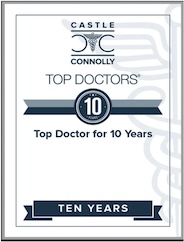Urogynecology Updates for Physicians
FPMRS Update July 2013 Highlights for Your Practice
Summary of the 2010 AUA Guidelines for the Treatment of Acute Uncomplicated Cystitis and Pyelonephritis: What You Need to Know-Their Thoughts and Mine.
As gynecologists, we are keenly aware of the incidence, pathophysiology and clinical presentations of UTIs in women. In the U.S., incidence is 12%, and 25% of UTIs recur in 6 months. Age increases the risk, noted in about 50% of women by age 80. Recurrent UTIs, defined as 3 or more UTIs in a year, are noted in 10% of women at age 60. 70-90% of UTIs are caused by E.coli. Despite numerous myths and reports of touted risk factors, none of the following have ever been shown in studies to increase the risk of UTIs: pre or post-coital voiding patterns, wiping, beverage consumption, voiding habits (delayed), douching, tampons, type of underwear, hot tubs or BMI.*
Because of this high incidence in women, this summary of current recommendations can be a quick reference guide for you in your practice:
1) Diagnosis
Urine culture with 100,000 or greater CFUs of < 3 bacteria AND one sign or symptom of cystitis (e.g.- urgency, frequency, dysuria, fever, or suprapubic tenderness)
Alternate diagnosis criteria include two signs or symptoms of cystitis AND urinalysis (ua) with leukocyte esterase and/or nitrites or pyuria on microscopic ua or gram stain with organisms
About 50% of UTIs do not show hematuria on microscopic exam.
2) Treatment
Antimicrobial resistance to antibiotics is a huge problem, so these guidelines were intended to balance patient risk with community risk
Nitrofurantoin monohydrate/macrocrystals (Macrobid)100mg bid for 5 days.
Trimethoprim-sulfamethoxazole (Bacrtrim DS) 160/800mg bid for 3 days. Only if local resistance is < 20%.
Fosfomycin trometamol (Monurol) 3g single dose. This one is slightly inferior in efficacy to the longer doses, but may be valuable in noncompliant patients.
Fluoroquinolones in 3 day regimens are highly effective in treating UTIs, but are so important in the treatment of other bodily infections that their use is limited to complicated UTIs like pyelonephritis and recurrent cystitis.
Beta lactams like Augmentin and cephaclor and cephalexin are useful in 3-7 day regimens, but only when other recommended agents cannot be used. Amoxicillin and ampicillin should be avoided due to their poor efficacy.
Of course, a urine culture with sensitivities can define the best treatment agent. The above recommendations are useful when sensitivities are not available (e.g.- phone diagnoses or symptoms occurring on Friday afternoon)
3) Acute uncomplicated pyelonephritis
Urine culture and sensitivity should always be performed.
In women not requiring hospitalization, oral ciprofloxacin 500mg bid x 7 days is recommended. If community resistance is known to be > 10%, add 1g ceftriaxone IV/IM at the start of the regimen. Levaquin 750mg po qd x 5 days is also acceptable. So is Bactrim DS bid x 14 days. Oral beta lactams are less effective, and if required, should be preceded by a one time IV dose of an aminoglycoside or ceftriaxone.
In women requiring hospitalization, multiple IV regimens are effective and should be tailored to local sensitivities.
4) Prophylaxis
Continuous prophylaxis can decrease recurrent UTI risk dramatically. Regimens can include one pill qhs dosing of: Bactrim (single or double strength), nitrofurantoin 50 or 100mg, cephalexin 125 or 250mg, trimethoprim 100mg, or fosfomycin 3gm q 10d. A 6 month trial seems appropriate.
Postcoital prophylaxis is also very effective. Single doses of the above medications are taken pericoitally.
Don’t be afraid to allow for self-diagnosis and treatment: patient satisfaction is higher due to fewer traditional visits to the provider and there is less antimicrobial exposure to antibiotics than with continuous prophylaxis. I give patients a standing prescription for any of the above regimens to use throughout the year or when traveling.
Interstitial cystitis symptoms can be easily confused with infectious cystitis, so a urine culture can come in handy during these episodes to confirm infection and any resistance.
The only other prophylactic agent proven in studies to decrease the risk of UTIs in postmenopausal women is the regular use of vaginal estrogen preparations. Studies show oral or transdermal preps do not seem to work. Neither do cranberries.
5) Referral
More complicated UTIs may require further evaluation by a urogynecologist or urologist. Imaging of the urinary tracts and/or cystoscopy may be indicated in recurrence, persistence, upper tract disease, comorbidities, or known anomalies. Smokers and elderly patients may require an evaluation for malignancy if recurrence or persistence is noted. Causes of recurrence include urethral diverticula, urinary tract malformations, stones, fistula, malignancy, diabetes, immune deficiencies, and urinary retention.
I hope that this summary of recommendations from the AUA, our AUGS review course, and myself is helpful to you. I wish you success in your practice.
Joseph Gauta, MD, FACOG
* Swift, S. Urinary Tract Infection. Comprehensive Review Course in Female Pelvic Medicine and Reconstructive Surgery. Dallas, TX. Feb 2013.
Excerpts from Gupta K, Hooton TM, Naber KG, et al. International Clinical Practice Guidelines for the Treatment of Acute Uncomplicated Cystitis and Pyelonephritis in Women: A 2010 Update by the Infectious Diseases Society of America and the European Society for Microbiology and Infectious Diseases. Clin Infect Dis 2011;52(5):e103-e120.
Call 239-449-7979 or Contact Us today!
It's time to start living your life to the fullest. Regain control of your life.










